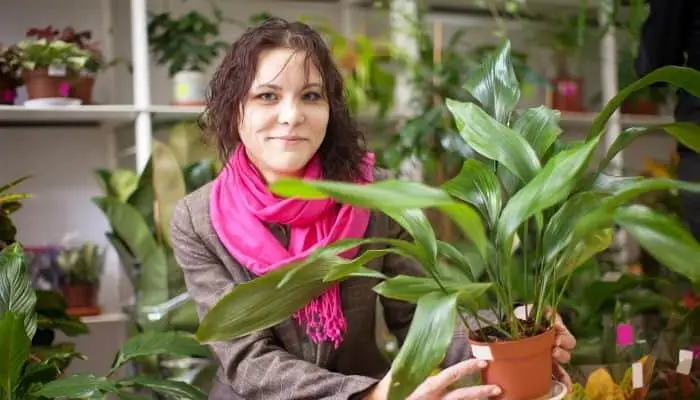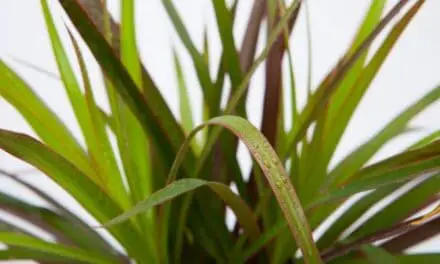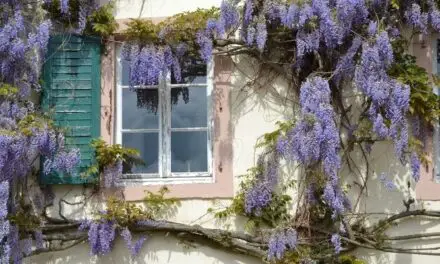Aspidistra elatior gets its nickname ‘cast iron plant’ because it’s, basically, a botanical Terminator.
It is practically indestructible!
This survivor of the plant world can deal with poor light, low temperatures, drought and will even flourish if it has been abandoned for a while.
However, even the hardy cast iron plant can end up changing the color of its leaves if it becomes unhappy.
Table of Contents
Why Is My Cast Iron Plant Turning Yellow?

Your cast iron plant is turning yellow because it is either being overwatered or exposed to too much direct sunlight.
These plants a super tough and can withstand a wide range of growing conditions and a lot of neglect.
But they do have a couple of weaknesses that you must be aware of.
Those weaknesses are overwatering and exposure to direct sunlight.
Too much of either of these and your cast iron plant’s health is going to go downhill fast.
Let’s take a closer look at both of these causes of yellowing leaves and see what you can do to get your plant back to looking lush and green again.
Overwatering
Outside of cacti and succulents, cast iron plants are some of the most drought tolerant you will come across.
It’s really easy to damage this plant from overwatering.
Thankfully, the signs of overwatering are pretty obvious and if you act quickly you can get your plant back on track.
The leaves will turn yellow and the tips might start to become brown.
To make sure your cast iron plant is not being overwatered, you need to let its soil dry out almost completely between waterings.
If you’re unsure, it might be best to use a moisture meter.
Stick the meter into the soil all the way to the bottom and when it reads very dry, you can give it some water.
When you’re giving water, water your cast iron plant thoroughly.
Just make sure your soil and pot have good drainage and all the water can drain away from the plant’s roots.
And during the colder season, you might have to water your plant even less.
Just remember to allow the soil to completely dry out between watering times.
Cast iron plants are also sensitive to chemicals like chlorine so they shouldn’t be watered directly from the tap.
You can collect rainwater, use bottled water, or leave tap water out in open containers for the chemicals to evaporate.
Also Read: Why Is My Coleus Turning Green? (And How To Keep It Colorful)
Too Much Direct Sunlight
Cast iron plants like the shade and don’t require bright light to keep their healthy green appearance.
They especially don’t like full sun and if they get too much of it their leaves will quickly bleach out and yellow.
Your green cast iron plant doesn’t tolerate full sunshine at all.
The best spot for this plant is back from direct sunlight; perhaps deeper into the shady corner of a room or back from a north-facing window, where there’s less exposure.
If you want this plant to grow as fast as possible, provided it with lots of indirect sunlight.
And if you want it to grow slowly so that you don’t have to move it or repot it for years, keep it in a shadier spot and it will grow much slower but still manage to keep its lovely green leaves.
Unlike a lot of others, your cast iron plant won’t mind living in a more shaded area, away from the sun.
If the home of your cast iron plant is a dark, cool place, then you would have to water it even less often.
Other Reasons Why Your Cast Iron Plant Is Turning Yellow
If your cast iron plant’s yellowing leaves are not down to a watering or light issue then there are a few other less common causes worth looking into.
You Repotted It
Cast iron plants grow very slowly and do not take well to being disturbed.
Unnecessary repotting will result in stress and yellowing leaves.
You may think that repotting will make your plant thrive even more, but that’s not the case with a cast iron plant.
Their root structure is small compared to their size above the soil.
So even when they look like they are really filling up a pot, they are still probably just fine where they are.
You will rarely have to repot your cast iron plant.
For a young plant, that’s one time per year.
While for ‘grown-ups’ it’s only about once every 3-4 years or so.
Regular unnecessary repotting has been known to even kill some cast iron plans.
Spider Mites
When spider mites feed on your cast iron plant’s leaves, they damage tissue and leave behind yellow spots that eventually spread and cause leaves to wilt and fall off.
Spider mites are tiny sap-sucking insects that usually live on the undersides of leaves.
These damaging pests can produce silk webs around the plant to protect themselves.
Unfortunately, a cast iron plant is at risk of getting infested by spider mites and a symptom of this can be leaves turning yellow.
To avoid this unpleasant situation, check your plant regularly for mites (pay extra attention to the undersides of the leaves).
The creatures might be difficult to see, so you can take a paper towel and wipe the back of the leaves.
If the towel turns yellow your cast iron plant may be infested.
Also, watch out for little spiderwebs and tiny holes in your plant’s foliage.
To treat spider mites on your cast iron plant, first hose it down to dislodge as many bugs as possible.
A hosing down every now and then also helps to keep the leaves hydrated and get rid of any dust that has settled on them.
Once hosed down, give the whole plant a spray with neem oil and it should be enough to eliminate what’s left of the spider mites.
Dusty Leaves
Because cast iron plants have such massive leaves with large surface areas, a build-up of dust can stop them from photosynthesizing properly and cause poor leaf health, including yellowing.
If you notice a little dust build-up, wipe down the leaves of your cast-iron plant with a damp cloth to remove the layer of dust.
And if you notice any dead or dying leaves it’s best to cut and remove them from as close to the soil as you can.
Dead leaves rotting around your plant could encourage pests and disease and may do much more harm than good.
Final Thoughts
The cast iron plant is one of the easiest to look after but if it’s overwatered or exposed to too much full sun its leaves can often start to turn yellow.
Thankfully, dealing with this issue is not too difficult once you take action fairly quickly.
Make sure that you’re not overwatering the guy, that it’s out of direct sunlight, and that spider mites are not weaving webs on it.




